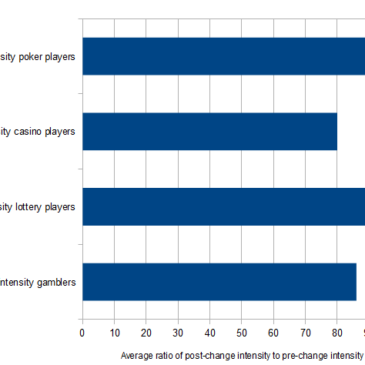Many online gambling operators offer self-limiting features, allowing players to set limits on how much money or time they spend gambling. Although it is up to the player to set his or her own limits, once in place, the sites strictly enforce the limits. During 2008, Nelson et al. noted that players who used such features altered their behavior, gambling less than before they set the limits. More recently, Auer and Griffiths used a concept they call “theoretical loss” (explained in more detail below) to explore whether self-imposed limits change the behavior of what they consider “high-intensity” gamblers. This week’s WAGER looks at how Auer and Griffiths define “high-intensity” and whether self-imposed time and deposit limit changes are associated with changes in the behavior of high-intensity gamblers (Auer & Griffiths, 2013).
Methods
- The online gambling site win2day collected a random sample of 100,000 users.
- During registration, win2day requires every user to set initial time and deposit limits.
- Auer and Griffiths drew a subsample of 5,000 users[1] from the random sample and obtained records of every bet the users placed on three games (lotteries, casino games, and poker) and every instance where a user changed his or her time and/or deposit limits[2] during a 3-month period.
- For each bet, the researchers calculated the “theoretical loss” by multiplying the size of the bet (for example, 10 EURO) by the house advantage. They defined a user’s gambling intensity (overall, and within each game) as the sum of the resulting values. The result is the researchers’ proxy for gambling intensity.
- For each instance where a user changed a time or money limit, they calculated the gambling intensity for the 30 days before the change.
- The researchers defined the high-intensity gamblers as the 10% of the users with the highest 30-day gambling intensities before a change in limits, overall and within game types.
- The researchers compared high intensity gamblers’ 30-day pre-change gambling intensities to their 30-day post-change gambling intensities to examine how their behavior changed.
Results
- The researchers observed significant reductions in gambling activity following change behavior. On average, the high intensity gamblers’ post-change gambling intensity was 86% of their pre-change gambling intensity.
- On average, high-intensity lottery players’ post-change lottery intensity was 90% of their pre-change gambling intensity. The corresponding average percentages for high-intensity casino players and high-intensity poker players were 80% and 89%, respectively.
Figure. Average ratio of post-change gambling intensity to pre-change gambling intensity for three sub-groups and across all high-intensity gamblers (adapted from Auer and Griffiths, 2013). Smaller ratios indicate greater decreases after setting limits. Click image to enlarge.
Limitations
- The authors suggest that theoretical loss, or expected value, is a more valid proxy of gambling intensity than other aspects of gambling behavior (e.g., bet size, number of games played), but no studies have provided conclusive evidence for this claim (for a discussion of this issue, please see Braverman et al., in press).
- For poker, the researchers used the rake as a substitute for expected value. The actual calculation of expected value in poker is a complicated process, and the rake is a poor substitute at best. Using the rake may have distorted some of the results.
- The researchers did not specify how they handled users who changed their betting limits multiple times over the 3-month period.
- The data covers only a 3-month period and only subscribers to one gambling site. It may not be representative of a longer period or the online gambling community as a whole.
Conclusions
Research has shown that self-limitation affects online gambling behavior (Nelson et al., 2008). Auer and Griffiths’ results suggest that voluntarily setting limits also might be an effective way of controlling the betting activities of high-intensity gamblers. By building the enforcement into the software itself, the sites take the decision away from the player during active gambling sessions, a time that might impair decision-making. In games where players’ decisions matter more, such as blackjack and poker, these self-limiting features can help gamblers make sure that they play only when their minds are clearer, they are playing their best, and they have the proper perspective on their wins, losses, and time spent.
-Matthew Tom
What do you think? Please use the comment link below to provide feedback on this article.
References
Auer, M., & Griffiths, M. D. (2012). Voluntary Limit Setting and Player Choice in Most Intense Online Gamblers: An Empirical Study of Gambling Behaviour. Journal of Gambling Studies. doi:10.1007/s10899-012-9332-y
Braverman, J., Tom, M. A., & Shaffer, H. J. (2013). Tilting at Windmills: A Comment on Auer and Griffiths. Journal of Gambling Studies. doi:10.1007/s10899-013-9428-z
Nelson, S. E., LaPlante, D. A., Peller, A. J., Schumann, A., LaBrie, R. A., & Shaffer, H. J. (2008). Real Limits in the Virtual World: Self-Limiting Behavior of Internet Gamblers. Journal of Gambling Studies, 24(4), 463–477. doi:10.1007/s10899-008-9106-8
________________





